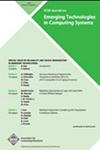Machine Learning Enabled Solutions for Design and Optimization Challenges in Networks-on-Chip based Multi/Many-Core Architectures
IF 2.6
4区 计算机科学
Q3 COMPUTER SCIENCE, HARDWARE & ARCHITECTURE
引用次数: 1
Abstract
Due to the advancement of transistor technology, a single chip processor can now have hundreds of cores. Network-on-Chip (NoC) has been the superior interconnect fabric for multi/many-core on-chip systems because of its scalability and parallelism. Due to the rise of dark silicon with the end of Dennard Scaling, it becomes essential to design energy efficient and high performance heterogeneous NoC-based multi/many-core architectures. Because of the large and complex design space, the solution space becomes difficult to explore within a reasonable time for optimal trade-offs of energy-performance-reliability. Furthermore, reactive resource management is not effective in preventing problems from happening in adaptive systems. Therefore, in this work, we explore machine learning techniques to design and configure the NoC resources based on the learning of the system and applications workloads. Machine learning can automatically learn from past experiences and guide the NoC intelligently to achieve its objective on performance, power, and reliability. We present the challenges of NoC design and resource management and propose a generalized machine learning framework to uncover near-optimal solutions quickly. We propose and implement a NoC design and optimization solution enabled by neural networks, using the generalized machine learning framework. Simulation results demonstrated that the proposed neural networks-based design and optimization solution improves performance by 15% and reduces energy consumption by 6% compared to an existing non-machine learning-based solution while the proposed solution improves NoC latency and throughput compared to two existing machine learning-based NoC optimization solutions. The challenges of machine learning technique adaptation in multi/many-core NoC have been presented to guide future research.基于片上网络的多/多核心架构中的设计和优化挑战的机器学习解决方案
由于晶体管技术的进步,一个单片处理器现在可以有数百个核心。片上网络(NoC)由于其可扩展性和并行性,已成为多核/多核片上系统的卓越互连结构。随着Dennard Scaling的结束,暗硅的兴起,设计节能、高性能的基于异质NoC的多核/多核架构变得至关重要。由于设计空间大而复杂,因此很难在合理的时间内探索解决方案空间,以实现能源性能可靠性的最佳权衡。此外,被动资源管理在防止自适应系统中出现问题方面并不有效。因此,在这项工作中,我们探索了基于系统和应用程序工作负载的学习来设计和配置NoC资源的机器学习技术。机器学习可以自动学习过去的经验,并智能地指导NoC实现其性能、功率和可靠性目标。我们提出了NoC设计和资源管理的挑战,并提出了一个通用的机器学习框架,以快速发现接近最优的解决方案。我们使用广义机器学习框架,提出并实现了一种由神经网络实现的NoC设计和优化解决方案。仿真结果表明,与现有的基于非机器学习的解决方案相比,所提出的基于神经网络的设计和优化解决方案提高了15%的性能,降低了6%的能耗,而与现有的两种基于机器学习的NoC优化解决方案相比,该解决方案改善了NoC延迟和吞吐量。机器学习技术在多核/多核NoC中的适应性挑战已被提出,以指导未来的研究。
本文章由计算机程序翻译,如有差异,请以英文原文为准。
求助全文
约1分钟内获得全文
求助全文
来源期刊
CiteScore
4.80
自引率
4.50%
发文量
86
审稿时长
3 months
期刊介绍:
The Journal of Emerging Technologies in Computing Systems invites submissions of original technical papers describing research and development in emerging technologies in computing systems. Major economic and technical challenges are expected to impede the continued scaling of semiconductor devices. This has resulted in the search for alternate mechanical, biological/biochemical, nanoscale electronic, asynchronous and quantum computing and sensor technologies. As the underlying nanotechnologies continue to evolve in the labs of chemists, physicists, and biologists, it has become imperative for computer scientists and engineers to translate the potential of the basic building blocks (analogous to the transistor) emerging from these labs into information systems. Their design will face multiple challenges ranging from the inherent (un)reliability due to the self-assembly nature of the fabrication processes for nanotechnologies, from the complexity due to the sheer volume of nanodevices that will have to be integrated for complex functionality, and from the need to integrate these new nanotechnologies with silicon devices in the same system.
The journal provides comprehensive coverage of innovative work in the specification, design analysis, simulation, verification, testing, and evaluation of computing systems constructed out of emerging technologies and advanced semiconductors

 求助内容:
求助内容: 应助结果提醒方式:
应助结果提醒方式:


